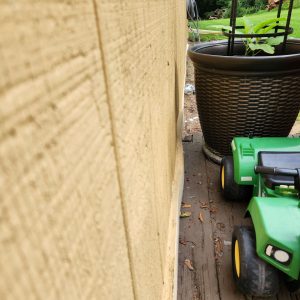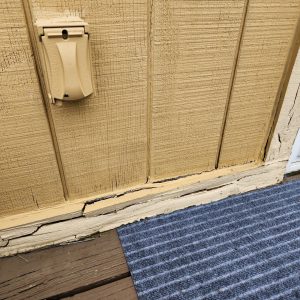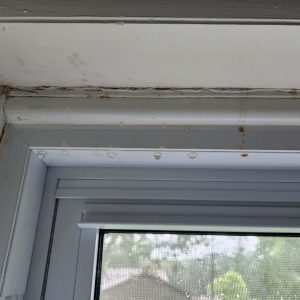When to Re-side / how to investigate the extent of potential water damage
Hello,
I’ve been considering whether or not to re-side my Michigan house, and how urgent it might be given the condition of the current siding. I believe the current siding is LP Smartside or something similar with a mix of some LP Smartside trim and some other trim. Looking at the current installation from the outside, I’m worried that the installer didn’t really have a good strategy for keeping bulk water out, relying on caulk in many places rather than flashing.
First sign that something was up, was that I noticed much of the trim on the house is rotting real bad(the previous owner had just painted over this, so it wasn’t apparent when purchasing the house). In some areas it’s falling apart and separating from the house, in others, it looks fine until you touch it, then you can tell it’ll just crumble if you do anything with it.
I also found a large spot of the existing siding that was spongy, and felt like I could just kick it in if I wanted to. Upon further inspection of the rest of the house as a result, I noticed a few other spots that look similar, and again were just painted over.
In one spot, the trim is bowing out by quite a bit, which makes me worry about what is going on inside that wall behind it…
The nail in the coffin was water coming in the house above the casing of an upstairs window… This freaks me out the most, as it shows water is definitely getting completely inside the wall enough to drip into the house during a rainstorm. I’m worried that the small amount of visible water in the house is the least of my problems…
If I were made of money, I’d redo the whole exterior of the house in a heartbeat. Strip it down to the studs, improve insulation while I’ve got access, then add zip sheathing and new siding/trim (probably vinyl for long-term durability and not having to worry about space for drainage/drying).
The problem is we were not prepared for this kind of expense only a couple years into this house. Theoretically, I could take out a loan to do all the work, but I’d really prefer to push this project back a couple years if I can to save up for it if I can.
So:
1. What can I do to determine what damage has already been done inside my walls without doing significant damage in the process?
2. What are the risks of doing some spot fixes and leaving this for a few years while we save?
Any advice you can provide would be greatly appreciated. Thanks!
Jonathan






















Replies
When was the house built?
Was there an inspection done prior to purchase?
Can you post some more pictures? Full shots of house, detail of windows and doors?
Thanks.
The original house was built in 1950, but it has been added on to multiple times and I couldn't get a record of when the additions were done(township says their records only go back to 1990 and their records from that time show the house as it is today).
Attached are pictures from when we bought the house a couple years ago. We did have an inspection prior to buying, but I don't think it was a very good one. He mentioned off-hand that flashing was missing in a few places, but didn't make a big deal about it, and we didn't push on it like we should have.
Let me know if there's a particular window or door you'd want a closer pic of.
The window that has water ingress above it is the top center window on the back of the house.
Sorry, got caught up in …….
From what I see in the larger photo’s, the install of the T-111 or (11) siding is suspect.
Use the search up top of the page for T-111 siding, and see what you can find regarding the install of T-111.
The lateral trim boards if nailed over the panels and no Z metal between the sheets…..
And the same goes for that bottom ribbon board (if it’s nailed over the sheets…..
The job relied on caulking (if you’re lucky) to keep water from getting behind the sheets and potentially getting to the framing, etc.
Your middle picture at the top (1st post) shows what can happen. Any sheets that hold moisture will rot and fail.
Windows need proper installation of both the window, the sheathing and the siding…..house wrap and peel and stick flashing included.
For someone to just throw on siding, caulk and paint…..they truly should be hung by their…….
I’d like to spend more time with this but am dragged away .
Might be back.
How’s the chimney area look?
So far no damage on the outside that I can tell, but it looks like that was just handled with caulk as well. I'm actually relatively familiar with how it's supposed to be done elsewhere, but realized I have no clue how you're supposed to flash around a chimney. Guess that's something I'll need to lookup as well.
The risk for putting work off while you save is that unseen leaks will cause extensive damage, making an expensive job even more so. You already know that there are major problems due to poor workmanship. They will only get worse.
Well, I was hoping for something a bit more specific. If it was just a matter of "Stop being cheap and just do it", I'd do it in a heartbeat. Especially because it will greatly improve the aesthetics of the house.
I know it's a problem and that it will just get worse, but my question is more, how fast will it get worse? I have some rotted sections, but not whole rotted walls, so if I leave it for a year or two, will I just have more rotted sections to replace(I'm looking to replace it all anyways), or will I be risking the house falling down due to rotting framing lumber? and is there a way to tell how extensive the current damage is without putting gaping holes in the siding or drywall?
Use an awl or some other sharp tool and start poking the soft spots near any nails you can see. If the tool goes in an inch or two the stud might be rotting behind the siding. Poke through the crumbling trim into some framing if you can.
Thanks! Simple but effective.
From what I can tell, there's only one spot of siding that's actually soft, and my tool hit a hard stop right behind it, so it seems the sheathing is still ok. Went right through the trim in a lot of spots, but always stopped at the siding. Apparently this LP Smartside is better than I thought? I also poked a few holes through the drywall near the window that was leaking in spots where I knew I had a stud, and still got a hard stop, so no damage there yet.
So here are my current thoughts. I'm probably being overzealous to want to replace the sheathing with zip(it just seems fun to build with...). So if I can scrounge together the cash this year, I think I would replace the siding and trim, but leave the sheathing (patching where needed as things come up). While the siding is off, I can get the WRB in better shape(I think there's house-wrap, but I bet it's not setup properly around the windows and doors), and flash everything properly. It's more affordable if the sheathing isn't needing to be replaced.
If I can't get it done this year, maybe I can caulk the heck out of that window that's leaking, and that should last a year, then I could do that siding/trim next summer.